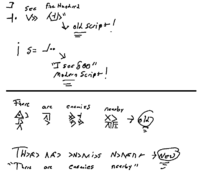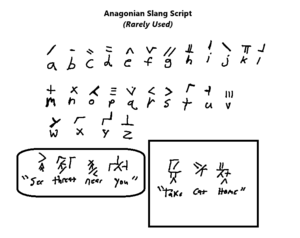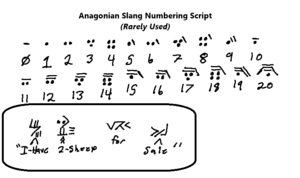History of the Anagonian Language
Introduction
The Anagonian Language is a rich tapestry of history and evolution, deeply influenced by its ancient roots in the Draconic Script and later transformed by the arrival of the Seurian invasion over two millennia ago. The earliest form of written communication in Anagonia can be traced back to the Drekamythian Dragons, whose primitive script formed the basis for the first version of the language.
Draconic Script required its users to combine symbols in a unique fashion, where letters were arranged both vertically and horizontally. Typically, a dragon would write a primary letter, followed by four additional letters directly below, creating a vertical stack. This method of combination could be repeated side by side to form longer words or phrases. The writing process was heavily tied to the practical needs of dragons and their environment. Draconic script was inscribed on stone and clay tablets using claw-like tools, later transitioning to primitive parchment or other materials that could hold ink made from natural substances like charcoal or plant-based dyes.
When it came to numbering, the system was rudimentary. To express quantities, dots or slashes were used alongside the symbols, often representing multiples of ten or, at most, hundreds. However, the system’s limitations became apparent, as more complex arithmetic concepts could not be easily conveyed in this ancient script. Still, this script served as the backbone of Anagonian communication, trade, and cultural exchange for centuries before the introduction of more advanced systems.
Approximately 2,422 years ago, the Seurian invasion forever changed the trajectory of the Anagonian language. As the Seurians brought with them their own written script and linguistic traditions, Anagonians, upon their victory in the war, began studying the strange symbols and words of the Seurians. Interestingly, they noticed a striking similarity between Seurian script and their own draconic claw marks. This realization sparked a slow but transformative process in which Seurian linguistic elements were gradually assimilated into the Anagonian script.
The influence of Seurian language on Anagonian culture was profound. Over time, as trade and cultural exchanges continued, Seurian syntax, numbering systems, and written forms began to merge with traditional Anagonian language. This process took centuries, leading to the creation of the Modern Anagonian Script, a hybrid of the ancient draconic symbols and the more structured Seurian script. This modern script, unlike its predecessor, was far better suited for the complexities of modern society, able to convey numbers, mathematical operations, and advanced written communication with clarity and precision.
History of Draconic Script
Draconic Language & Speech
History of the Modern Anagonian Script
Modern Anagonian Language & Speech
Evolution of Numbers and Mathematics
The development of numbers and mathematics in Anagonian language, from Pre-Seurian era into the Modern, reflects the nation’s journey from primitive counting systems to complex numerical representations, influenced by both draconic traditions and external cultures. Early Anagonians relied on basic tally marks, derived from the claw-like symbols of the Draconic Script, to denote quantities. These symbols were primarily used for rituals, trade, and territorial markings, and could represent simple counts or multiples, such as tens or hundreds, using dots and slashes to indicate larger numbers.
Pre-Seurian Mathematics: The Draconic Bane
While the early Anagonians revered the dragons for their wisdom and strength, mathematics was not exactly the strong suit of these ancient, towering creatures. Draconic mathematics, if it could be called that, was limited to basic counting and symbolic representations of quantities, largely for practical purposes such as marking territory or tracking ritual offerings. The dragons, though intelligent and wise in many ways, viewed mathematics as unnecessary drudgery, a bane that served little purpose in their lives of power and dominance. For them, the natural world was measured through instinct and intuition, rather than precise calculation.
The early Anagonians adopted this primitive mathematical system, relying on claw-like symbols scratched into stone or clay to represent simple numbers. A single slash might denote one unit, while additional marks indicated multiples. The use of dots and slashes to represent tens or hundreds allowed for some larger counts, but there was no concept of complex calculations or abstract mathematical principles. Numbers were largely tied to ritualistic purposes, with certain quantities being seen as sacred or imbued with spiritual meaning.
However, the limitations of this system soon became apparent as Anagonia’s society advanced. While dragons had little need for advanced calculations, humans increasingly required more precise and versatile methods for counting resources, organizing trade, and expanding governance. The dragons’ system, despite its simplicity and effectiveness for their needs, was soon seen as a hindrance to human progress.
Post-Seurian Mathematics: Numerical Renaissance
The arrival of the Seurians brought about a transformative period in Anagonia’s history, particularly in the realm of mathematics. Often referred to as a Numerical Renaissance, this era saw the introduction of the Seurian base-10 system, which revolutionized the way Anagonians approached numbers and calculations. Unlike the primitive draconic system, which relied on simple tallies and ritualistic meanings, the Seurian approach to mathematics introduced structured symbols for numerals, as well as operations like addition, subtraction, multiplication, and division. This allowed Anagonians to move from basic counting to complex arithmetic, a development that would fuel the nation’s economic and technological progress.
Seurian mathematics introduced the concept of positional value—the idea that the position of a digit affects its value—which enabled Anagonians to work with larger numbers and perform more sophisticated calculations. This advancement was crucial for the organization of the expanding Mal-Videnus Commonwealth, as it provided the mathematical foundation necessary for everything from taxation and resource management to architecture and engineering.
With this new system, Anagonia entered an era of intellectual growth, as scholars and traders quickly adopted and adapted Seurian principles to fit the needs of their growing society. The Numerical Renaissance laid the groundwork for Anagonia’s technological innovations, establishing a tradition of mathematical excellence that would continue into the modern age.
The Modern Era: Freedom of Mathematics
In the modern era, Anagonia has fully embraced the freedom of mathematics, pushing the boundaries of numerical theory, applied sciences, and technology. Building on the foundations laid during the Numerical Renaissance, the Anagonian people have moved beyond the rigid systems of the past and entered a period of intellectual liberation. Mathematics is no longer just a tool for governance and trade—it has become an essential part of everyday life, driving scientific discovery, technological innovation, and even the arts.
With the rise of computers, artificial intelligence, and automation, mathematics has found new applications in areas ranging from space exploration to environmental preservation. The digital revolution has allowed Anagonians to create advanced algorithms and models that can solve complex problems in real-time. This newfound flexibility has led to the development of new mathematical fields, such as quantum computing and cryptography, which have become vital for national security and global communications.
Mathematics education has also seen a renaissance of its own. Students from all walks of life are encouraged to engage with numbers, from basic arithmetic to high-level calculus and theoretical physics. The introduction of digital learning platforms has made math accessible to everyone, enabling people to explore the freedom of mathematical expression in new and exciting ways. The blending of traditional Anagonian values with modern mathematical innovation reflects the nation’s ongoing quest for progress, excellence, and the freedom to explore new frontiers.
Key Milestones in Mathematical Evolution
Key milestones in the evolution of Anagonian mathematics include:
- Pre-Seurian Era: In ancient times, numerical concepts were rudimentary, focused mainly on practical uses like tracking resources or marking distances. The early system was heavily tied to ritual practices, where numbers often represented spiritual concepts connected to dragons and natural phenomena. However, these systems were limited in their ability to handle large quantities or complex calculations.
- Seurian Influence: The introduction of the Seurian numeric system during the Seurian invasion revolutionized Anagonia’s approach to numbers. The Seurians brought a more structured system capable of handling advanced arithmetic, which was quickly adopted by Anagonian scholars and traders. The base-10 system, along with symbols for addition, subtraction, multiplication, and division, enabled Anagonia to develop more sophisticated forms of mathematics.
- Mal-Videnus Commonwealth and Standardization: During the formation of the Mal-Videnus Commonwealth, the Seurian numeric system was integrated with elements of the traditional draconic counting system to create a unified system for use in governance and trade. This new system expanded to include formal notation for mathematical operations, allowing Anagonia to engage in complex engineering and architectural projects.
- Modern Era and Digitalization: In the modern era, Anagonia’s numeric system has been adapted for use in technology, including computers, financial systems, and scientific applications. The shift to digital formats required the script to be optimized for precision and efficiency, resulting in the creation of modern mathematical symbols and fonts that blend traditional aesthetics with contemporary functionality.
Anagonian Slang Script & Language
Though Modern Anagonian is widely used in urban centers and formal settings, a more informal, rural variant known as the Anagonian Slang Script persists in the remote regions of Anagonia. This script is primarily used by those living in the "boonies" or "backhills", far from the influence of urban education centers. Any Anagonian, regardless of race or background, who grows up in these rural areas and receives even the most basic education will be familiar with this script.
The Anagonian Slang Script is a fusion of Old Draconic Script and Modern Anagonian, but with a notable difference: it adheres to the traditional Draconic writing rules, such as structuring words in rows and columns, often written vertically or in block patterns, as opposed to the linear, left-to-right format of Modern Anagonian. This gives the script a rougher and more ancient appearance, reminiscent of the older days when the Draconic Script dominated written communication.
The language that accompanies this script is equally rough and reflects the informal, rural dialects of ancient Anagonia. In many ways, it can be considered Anagonia’s version of "southern slang," where pronunciation is less refined, words are abbreviated or slurred, and sentence structure is more flexible. This slang often invokes older phrases, expressions, and metaphors that have long since fallen out of use in urban centers but remain popular in rural regions.
Anagonian Slang Audio Clip Example
Mathematical Slang Script Variant
In addition to the language itself, there is also a rudimentary form of mathematical slang script used in rural areas. This variant still follows the basic principles of Draconic mathematics, incorporating simple symbols and markings to denote numbers. However, in keeping with the informal nature of the script, these markings are often abbreviated, with symbols for multiplication, division, and addition simplified to slashes, dots, or crosses.
This mathematical slang is only suitable for basic arithmetical operations, such as counting, trading, or simple transactions within local communities. More complex calculations are seldom needed, and when required, individuals from these rural regions often turn to the standardized Modern Anagonian system for precision.



